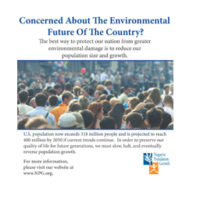While Increasing Fuel Efficiency is a Positive Step, America is Still Missing the Real Solution
- Tracy Henke
- May 22, 2014
- President's Column
- 0 Comments
Just a few days after his State of the Union address, President Obama followed through on his promise to work against climate change. According to USA Today, he “ordered the Environmental Protection Agency [EPA] and the Transportation Department’s National Highway Traffic Safety Administration [NHTSA] to develop and issue new fuel-efficiency and greenhouse gas standards by March 31, 2016.” Environmentalists hailed the order as a victory, and “the White House projects the country will save about 530 million barrels of oil – more than what is imported annually from Saudi Arabia – and reduce greenhouse gas emissions by 270 million metric tons.”
NPG certainly applauds this effort – as we will encourage any reasonable, responsible methods to curb America’s disproportionate and insatiable consumption of limited natural resources. We must become far better stewards of our environment, and we must learn to live on less. However, according to the U.S. Energy Information Administration (EIA), in 2011 America consumed a total of 6.87 billion barrels of refined petroleum products and biofuels – that is 18.83 million barrels per day. At that rate, President Obama’s mandate would only save our nation 28 days’ worth of oil. Is this really the “solution” it was heralded as, or just another misleading promise – one that buys us a little more time with the status quo, so that America doesn’t have to change?
One of President Obama’s other comments highlights what NPG sees as the real root of our nation’s challenge: “Every time someone says you can’t grow the economy while bringing down pollution, it turns out they’ve been wrong.” It seems, once again, Americans are being told we must grow-grow-grow our way to “freedom” from our environmental and economic challenges.
In a President’s Column last summer, NPG drew attention to the state of our nation’s energy sector and infrastructure. In its 2013 Report Card for America’s Infrastructure, the American Society of Civil Engineers (ASCE) noted: “the availability of energy… will become a greater challenge… as the population increases.” Yet another President’s Column explored the link between population growth and greenhouse gas emissions, concluding: “our population size is the principal determinant of the size of our greenhouse gas emissions.”
The reality, often dismissed or ignored by our elected officials and business leaders, is this: no matter what technological advances, usage limitations, improved efficiencies, and conservation efforts the United States implements, we will never – NEVER – undo the damage of our nation’s population growth.
Consider this report by the EIA: in 2011, the U.S. was responsible for over 5,490 million metric tons of carbon dioxide emissions from the consumption of energy.
- The entire of North America emitted 6,506.960 million metric tons in 2011 – making the U.S. responsible for nearly 85% of our continent’s emissions.
- The worldwide emissions for 2011 were 32,578.645 million metric tons – making the U.S. responsible for nearly 17% of the world’s emissions.
- In 2011, world population was nearing 7 billion and U.S. population was estimated at roughly 312.8 million. With less than 5% of world population, we are emitting 17% of the carbon dioxide.
- Obama’s strategy, while a step in the right direction, would only eliminate 270 million metric tons of greenhouse gas emissions – less than 5% of our annual emissions.
According to the Worldwatch Institute, 2012 yielded the world’s highest annual total of CO2 emissions in history. That same year, world population exceeded 7 billion and U.S. population reached over 315 million – and both continued to grow… and grow… and grow. It seems painfully clear that our world’s overall emissions continue to rise – despite global efforts to decrease them. We must recognize the link between this trend and the growth of both U.S. and world population.
In 2013, NPG updated and republished our Forum paper Overpopulation and Overconsumption: Where Should We Focus? Author Michael G. Hanauer thoroughly explores this important question, and concludes:
- Technology rarely produces lasting solutions – only additional difficult choices and tradeoffs;
- Overpopulation actually occurs at a lower point with a higher standard of living; and
- Population growth directly drives increasing overall consumption.
It seems that, while President Obama’s efficiency mandate will certainly reduce our grossly-inflated emissions – and any step to protect our fragile environment is crucial, this will come nowhere near to solving our problem. This effort will not create a lasting, sustainable America for generations to come.
The only permanent solution to America’s problem – or the world at large – is for us to slow, halt, and eventually reverse our population growth. We must reduce the overall number of consumers making demands on our environment and natural resources. Only then can we preserve a livable future, one that is sustainable over the very long term.
Tracy Henke served as Deputy Director of NPG from 2012 to 2017, contributing to the structure and development of NPG’s publications programs. Acting as NPG’s principal editor and a contributing author – as well as a regular contact for the public and media, Tracy extensively researched U.S. population issues and worked to establish significant grassroots support for the NPG mission. She holds a degree in Leadership & Social Change from Virginia Tech, with a professional background in non-profit and program management.

